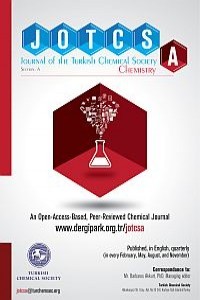Anticancer Activity of Papaver Somniferum
Anticancer Activity of Papaver Somniferum
___
- World Cancer Report 2014. http://www.iarc.fr/en/publications/books/wcr/wcr-order.php (accessed 16.04.16).
- Elgorashi E. Screening of medicinal plants used in South African traditional medicine for genotoxic effects. Toxicol. Lett. 2003; 143, 195–207. doi:10.1016/S0378-4274(03)00176-0.
- Fennell CW, Lindsey KL, McGaw LJ, Sparg SG, Stafford GI, Elgorashi EE, Grace OM, van Staden J. Assessing African medicinal plants for efficacy and safety: pharmacological screening and toxicology. J. Ethnopharmacol. 2004; 94, 205–217.
- Sithranga Boopathy N, Kathiresan K. Anticancer Drugs from Marine Flora: An Overview. J. Oncol. 2010; 1–18. doi:10.1155/2010/214186.
- Weerapreeyakul N, Nonpunya A, Barusrux S, Thitimetharoch T, Sripanidkulchai B. Evaluation of the anticancer potential of six herbs against a hepatoma cell line Chin. Med. 2012; 7, 15.
- Lee CC, Houghton P. Cytotoxicity of plants from Malaysia and Thailand used traditionally to treat cancer. J. Ethnopharmacol. 2005; 100, 237–243.
- Berrington D, Lall N. Anticancer Activity of Certain Herbs and Spices on the Cervical Epithelial Carcinoma (HeLa) Cell Line. Evidence-Based Complement. Altern. Med. 2012; 1–11.
- Itharat A, Houghton PJ, Eno-Amooquaye E, Burke P, Sampson JH, Raman A. In vitro cytotoxic activity of Thai medicinal plants used traditionally to treat cancer. J. Ethnopharmacol. 2004; 90, 33–38.
- Gürkök T, Parmaksız İ, Boztepe G, Kaymak E. Alkaloid biosynthesis Mechanism in Opium Poppy (Papaver somniferum L.). Electronic Journal of BioTechnology 2010; 1(2) 31-45.
- Parmaksiz I, Özcan S. Morphological, chemical and molecular analyses of Turkish Papaver accessions (Sect. Oxytona). Turk J. Bot. 2011; 35, 1-16.
- Gürkök T, Kaymak E, Boztepe G, Koyuncu M, Parmaksız İ. Molecular characterization of the genus Papaver section Oxytona using ISSR markers. Turk J. Bot. 2013; 37:644-650.
- Chen X, Dang T-TT, Facchini PJ. Noscapine comes of age. Phytochemistry 2015; 111, 7–13.
- Priyadarshani A, Chuttani K, Mittal G, Bhatnagar A. Radiolabeling, biodistribution and gamma scintigraphy of noscapine hydrochloride in normal and polycystic ovary induced rats. J. Ovarian Res. 2010; 3, 10.
- Mahmoudian M, Rahimi-Moghaddam P. The anti-cancer activity of noscapine: a review. Recent Pat. Anticancer. Drug Discov. 2009; 4, 92–7.
- Takeuchi R, Hoshijima H, Onuki N, Nagasaka H, Chowdhury SA, Kawase M, Sakagami H. Effect of anticancer agents on codeinone-induced apoptosis in human cancer cell lines. Anticancer Res. 2005; 25, 4037–41.
- Sueoka E, Sueoka N, Kai Y, Okabe S, Suganuma M, Kanematsu K, Yamamoto T, Fujiki H. Anticancer activity of morphine and its synthetic derivative, KT-90, mediated through apoptosis and inhibition of NF-kappaB activation. Biochem. Biophys. Res. Commun. 1998; 252, 566–70.
- Porstmann T, Ternynck T, Avrameas S. Quantitation of 5-bromo-2-deoxyuridine incorporation into DNA: an enzyme immunoassay for the assessment of the lymphoid cell proliferative response. J Immunol Methods 1985; 82(1): 169-79. doi:10.1016/0022-1759(85)90236-4.
- Segal MS, Goldstein MM, Attinger EO. The use of noscapine (narcotine) as an antitussive agent. CHEST Journal. 1957; 32(3), 305-9.
- Joshi HC, Zhou J. Noscapine and analogues as potential chemotherapeutic agents. Drug News Perspect. 2000;13(9), 543-6.
- Anderson JT, Ting AE, Boozer S, Brunden KR, Danzig J, Dent T. Discovery of S-phase arresting agents derived from noscapine. J. Med. Chem. 2005; 48, 2756–2758.
- Aneja R, Vangapandu SN, Lopus M, Chandra R, Panda D, Joshi HC. Development of a novel nitro-derivative of noscapine for the potential treatment of drug-resistant ovarian cancer and T-cell lymphoma. Mol. Pharmacol. 2006; 69, 1801–1809.
- Boke H, Ozhuner E, Turktas M, Iskender I, Sebahattin O, Unver T. Regulation of the alkaloid biosynthesis by miRNA in opium poppy. Plant Biotech. 2015; 1-12. DOI: 10.1111/pbi.12346.
- Gurkok T, Turktas M, Parmaksiz I, Unver T. Transcriptome Profiling of Alkaloid Biosynthesis in Elicitor Induced Opium Poppy. Plant Mol. Biol. Report. 2015; 33, 673–688.
- Facchini PJ, De Luca V. Opium poppy and Madagascar periwinkle: model non-model systems to investigate alkaloid biosynthesis in plants. Plant J. 2008; 54, 763–784.
- Alagöz Y, Gürkök T, Parmaksız İ, Ünver T. Identification and sequence analysis of alkaloid biosynthesisgenes in Papaver section Oxytona. TURKISH J. Biol. 2016; 40, 174–183.
- Gurkok T, Ozhuner E, Parmaksiz I, Özcan S, Turktas M, İpek A, Demirtas I, Okay S, Unver T. Functional Characterization of 4′OMT and 7OMT Genes in BIA Biosynthesis. Front. Plant Sci. 2016; 7.
- Başlangıç: 2014
- Yayıncı: Türkiye Kimya Derneği
Elmir Magsad BABAYEV, Arif Javanshir EFENDİ, Fakhriyya Mashallah NASİRİ, Bilqeyis Adil İSMAYİLOVA, Firuza Alasgar YUNİSOVA
DETERMINATION OF COCAINE AND BENZOYLECGONINE IN BIOLOGICAL MATRICES BY HPLC AND LC-MS/MS.
Zinar Pinar GUMUS, Veysel Umut CELENK, Emine GULER, Bilal DEMİR, Hakan COSKUNOL, Suna TİMUR
GREEN SYNTHESIS OF NEW AMINO ACID SCHIFF BASES AND THEIR BIOLOGICAL ACTIVITIES
Cigdem Yorur-Goreci, Zulal Demir, Nilay Altaş
Erdinç DOĞANCI, Mustafa Hikmet Bilgehan UCAR, Adnan SONDAS
Cigdem YORUR-GORECİ, Mehmet KAZİCİ, Sinem BOZAR, Zulal DEMİR, Abdullah TORAMAN, Fatih ONGUL, Abid ALİ, Serap GUNES
Electrochemical Decolorization of Reactive Violet 5 Textile Dye using Pt/Ir Electrodes
Bahadır K. Körbahti, Kezban Meltem Turan
İsa DEGİRMENCİ, Michelle L. Coote
Bahadır K. Körbahti, Kezban Meltem Turan
Gamze Elmas, Aytuğ Okumuş, Zeynel Kılıç, L. Yasemin Gönder, Leyla Açık, Tuncer Hökelek
